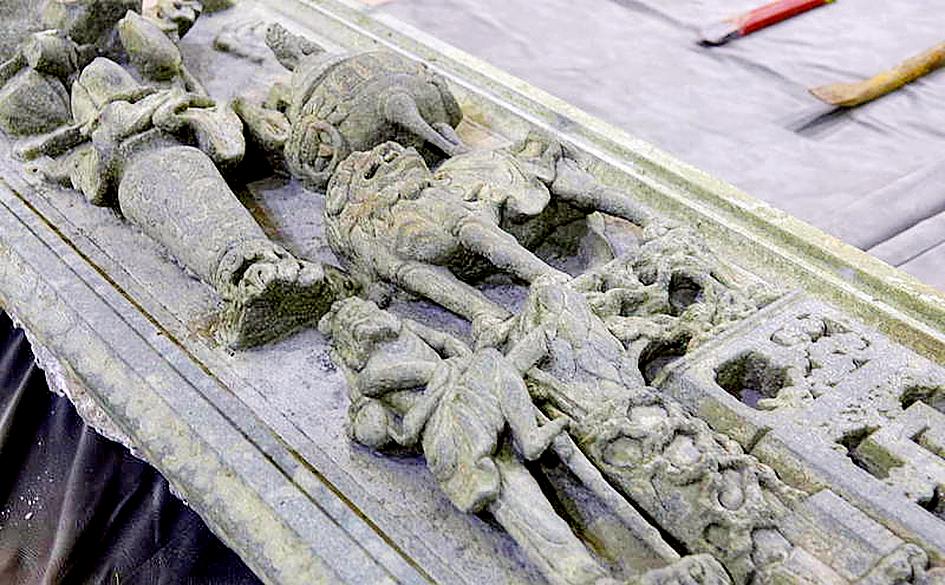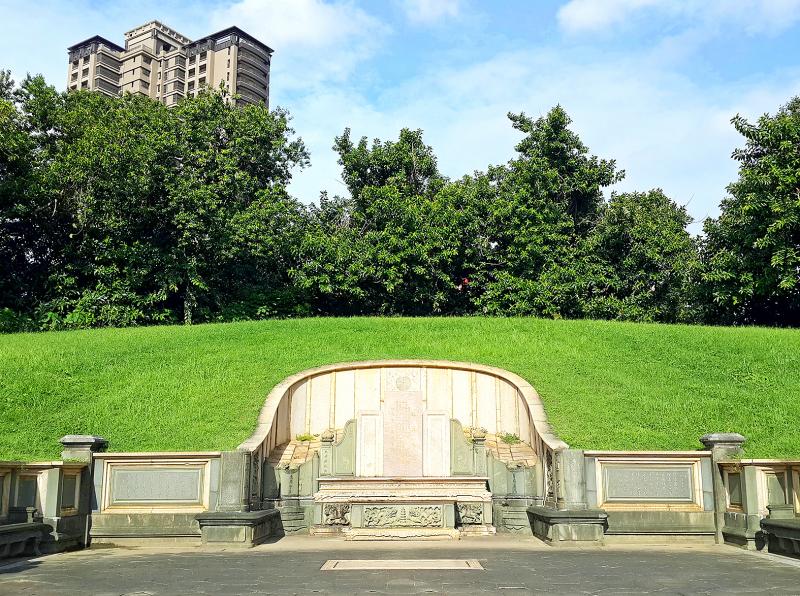Aug. 16 to Aug. 22
Huang Li-yung’s (黃禮永) descendants were shocked last month to see that their family grave had been desecrated — again.
Robbers had pried off the ornate stone carvings that flanked the headstone and made off with them. They probably hoped to sell the pieces for cash, as they were the handiwork of Chiang Hsin (蔣馨), whose relatives and disciples left their mark across Taiwan’s many temples and traditional structures.

Photo courtesy of Hsu Cheng-yuan
Huang made his fortune milling rice in the late 1800s, propelling his family to the upper echelons of Lukang society where they were only second in wealth to the still-prominent Koo clan. The “Gold and Silver Hall” (金銀廳) that Huang’s sons constructed was one of the area’s best-known landmarks, famed for its gold and silver screens — the former used at weddings and celebrations, the latter for funerals.
The family tomb was built in 1930 and is considered Chiang’s earliest such commission. The first time it was robbed, the police were able to retrieve the pieces. The police came through again last month, apprehending the culprit less than two weeks after the heist. He was an antiques collector.
Chiang is probably the best known in Taiwan out of numerous Chiangs who headed to Taiwan in the early 1900s from a stone-carving village in Huian County, Fujian Province. His first local project was the 1927 renovation of Lukang’s Tianhou Temple, for which he hired a number of Chiangs to help. Huang was one of the project’s main sponsors, and the two got to know each other then.

Photo: Liu Hsiao-hsin, Taipei Times
PRIZED SCREEN
There’s not all that much information about Huang’s life. Born in Lukang in 1864 to a family of merchants, he expanded the family’s rice milling business into the Qingyuan Company (慶源商號), which sold general goods as well. During the Japanese colonial era, Huang was active in the community, serving as neighborhood chief with a reputation for helping locals solve their problems. In 1946, Huang launched a donation drive to expand the Weiling Temple (威靈廟), and also funded the construction or renovation of several other public institutions.
To celebrate their mother’s birthday in 1935, Huang’s sons, Huang Chiu (黃秋) and Huang Chun-chieh (黃俊傑), built the Gold and Silver Hall in the family garden. It soon became a gathering spot for local elites and creatives, as they put on regular art gatherings, photography salons and other functions fancy for those times.

Photo courtesy of Wikimedia Commons
The famous screens were designed by 29 year old woodworker Lee Sung-lin (李松林), who was still trying to make his mark as the fourth-generation scion to a clan of woodworkers. It’s known for its fusion of local and Western aesthetics, something that’s also reflected in the structure’s interior. The Lees also came to Taiwan from China to fix temples and eventually settled — his great-grandfather arrived in the mid-1850s to help renovate Lukang’s Longshan Temple (龍山寺); two of his sons and three grandsons were also notable talents.
Lee Sung-lin began his career at the age of 15, helping to carve furniture for the Koo family mansion. His talent started to shine during a 1924 renovation of the Tianhou Temple and his work would be seen all over Taiwan in the next several decades, as he remained active into his 80s.
CLAN OF CARVERS

Photo courtesy of Chuang Yen-yu
Chiang Hsin also made a name for himself in Taiwan at the Tianhou Temple, although he died three years before his portion of the project was complete in 1936.
Nicknamed “Turtle Hsin” for his hunchback, Chiang originally ran a stone processing factory in China’s Xiamen Province and his products were often shipped to Taiwan to use in temples and graves. The 1919 renovations of Wanhua District’s (萬華) Longshan Temple partially used his prized bluestone (青斗石), and in 1926 he moved to Taiwan hoping for contracting work.
Chiang was not the first of his clan to move to Taiwan; it was in need of all sorts of artisans after the 1906 Chiayi Earthquake caused serious damage to structures throughout Taiwan.

Photo courtesy of Wikimedia Commons
Chiang Wen-shan (蔣文山) and Chiang Tung-tsai (蔣棟材) were among the earlier ones, commissioned in 1908 to carve dragon and flower columns at Beigang’s Chaotian Temple (朝天宮). Chiang Hsi-lai (蔣細來) helped with the Wanhua Longshan Temple renovations as well as the 1925 repairs of Shulin’s (樹林) Jian Temple (濟安宮); Chiang Mei-shui (蔣梅水) in 1924 worked on the Ciji Temple (慈濟宮) in Fengyuan.
Chiang Hsin reportedly enjoyed good relations with the Koo family, who also trace their roots to Huian, so he settled in Lukang, where many temples awaited resuscitation. Chiang won the bid for the Tianhou Temple project and recruited several of his clansmen, including Chiang Mei-shui, to help him. Chiang imported bluestone from Huian, which delayed the project and increased costs, but he insisted on the material. In 1929, the team completed another significant job with the rebuilding of Changhua’s Nanyao Temple (南瑤宮).
Chiang did a few more gravestone commissions after Huang’s, most notably that of Kaohsiung business magnate Chen Chung-ho (陳中和), which took five years to build. Chen’s casket has since been moved to the family plot, and the gravesite is now a municipal cultural relic.
It’s said that Chiang wasn’t the most skilled carver, but he had superb design capabilities and was an excellent strategist and project manager. He died in 1933 and his son-in-law Chang Chin-shan (張金山) took over his mantle. Projects under Chang include the 1938 post-fire reconstruction of Lukang’s Longshan Temple as well as Guangfu Temple in Siluo Township (西螺), Yunlin County.
The Huang family fortune collapsed after Huang Li-yung’s grandson was indicted for fraud. The family eventually faded into history and their prized buildings were left to ruin. The public only remembered them in early 2015, when the Qingyuan Company headquarters were razed without warning.
Fortunately, the Gold and Silver Hall survived, but a year later the proprietor decided to sell it. This sparked a local movement to save the structure, and in 2018 it was registered as a historic building — although it appears to remain in poor shape.
Taiwan in Time, a column about Taiwan’s history that is published every Sunday, spotlights important or interesting events around the nation that either have anniversaries this week or are tied to current events.

This is the year that the demographic crisis will begin to impact people’s lives. This will create pressures on treatment and hiring of foreigners. Regardless of whatever technological breakthroughs happen, the real value will come from digesting and productively applying existing technologies in new and creative ways. INTRODUCING BASIC SERVICES BREAKDOWNS At some point soon, we will begin to witness a breakdown in basic services. Initially, it will be limited and sporadic, but the frequency and newsworthiness of the incidents will only continue to accelerate dramatically in the coming years. Here in central Taiwan, many basic services are severely understaffed, and

Jan. 5 to Jan. 11 Of the more than 3,000km of sugar railway that once criss-crossed central and southern Taiwan, just 16.1km remain in operation today. By the time Dafydd Fell began photographing the network in earnest in 1994, it was already well past its heyday. The system had been significantly cut back, leaving behind abandoned stations, rusting rolling stock and crumbling facilities. This reduction continued during the five years of his documentation, adding urgency to his task. As passenger services had already ceased by then, Fell had to wait for the sugarcane harvest season each year, which typically ran from

It is a soulful folk song, filled with feeling and history: A love-stricken young man tells God about his hopes and dreams of happiness. Generations of Uighurs, the Turkic ethnic minority in China’s Xinjiang region, have played it at parties and weddings. But today, if they download it, play it or share it online, they risk ending up in prison. Besh pede, a popular Uighur folk ballad, is among dozens of Uighur-language songs that have been deemed “problematic” by Xinjiang authorities, according to a recording of a meeting held by police and other local officials in the historic city of Kashgar in

It’s a good thing that 2025 is over. Yes, I fully expect we will look back on the year with nostalgia, once we have experienced this year and 2027. Traditionally at New Years much discourse is devoted to discussing what happened the previous year. Let’s have a look at what didn’t happen. Many bad things did not happen. The People’s Republic of China (PRC) did not attack Taiwan. We didn’t have a massive, destructive earthquake or drought. We didn’t have a major human pandemic. No widespread unemployment or other destructive social events. Nothing serious was done about Taiwan’s swelling birth rate catastrophe.